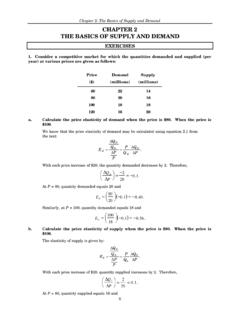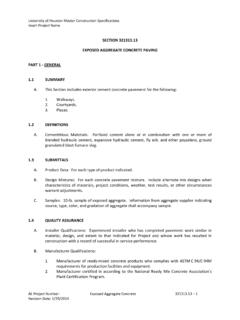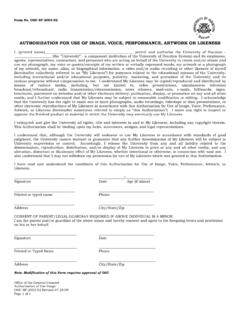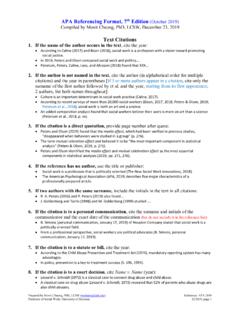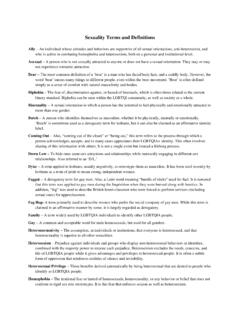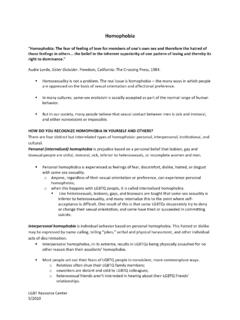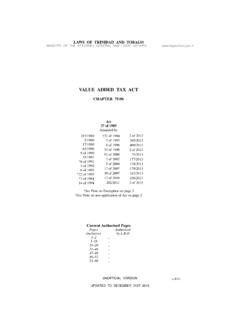Transcription of CAPITAL STRUCTURE [Chapter 15 and Chapter 16]
1 CAPITAL STRUCTURE [CHAP. 15 & 16] -1 CAPITAL STRUCTURE [ Chapter 15 and Chapter 16] CONTENTS I. Introduction II. CAPITAL STRUCTURE & Firm value WITHOUT Taxes III. CAPITAL STRUCTURE & Firm value WITH Corporate Taxes IV. Personal Taxes V. Costs of Financial Distress VI. Other Theories of & Issues in CAPITAL STRUCTURE Theory VII. Evidence on CAPITAL STRUCTURE VIII. Question Assigned I. Introduction CAPITAL STRUCTURE Policy involves a trade-off between risk and return 1) Using more debt raises the riskiness of the firm s earnings stream. 2) However, a higher debt ration generally leads to a higher expected rate of return.
2 Higher risk tends to lower a stock price, but a higher expected return raises it. Therefore the optimal CAPITAL STRUCTURE strikes a balance between risk and return so as to maximize a firm s stock price. We focus on impact of CAPITAL STRUCTURE changes on the: 1) value of the firm 2) value of existing bonds MISCELLANEOUS : IN THIS SECTION, S=E AND D=B AND USED INTERCHANGABLY. CAPITAL STRUCTURE [CHAP. 15 & 16] -2 II. CAPITAL STRUCTURE & Firm value WITHOUT Taxes A. Modigliani and Miller Proposition I [without taxes] The value of the firm is unaffected by its choice of CAPITAL STRUCTURE under perfect CAPITAL markets.
3 Note: Perfect CAPITAL markets - no taxes, no transaction costs, no bankruptcy costs, investors can borrow and lend at same rate as firms, free access to all information, etc. 1. Arbitrage proof Assume two firms have identical assets that produce the same stream of operating profit and differ only in their CAPITAL STRUCTURE . Firm U is unlevered ( , no debt): VU = EU Firm L is levered (debt) : VL = EL + DL Inv. Strategy #1 Inv. Strategy #2 Buy 10% of EL Buy 10% of EU & Borrow 10% of DL $ Inv. $ Return $ Inv. $ Return (profit-interest) (profit) (interest) Total (VL-DL) (profit-interest) (VU-DL) (profit-interest) 2) Proof also works if two strategies are: 1] Purchase 10% of unlevered firm's equity 2] Purchase 10% of levered firm's equity & lend 10% of DL (or buy 10% of levered firm's debt) CAPITAL STRUCTURE [CHAP.
4 15 & 16] -3 B. Modigliani and Miller Proposition II [without taxes] The expected rate of return on the common stock of a levered firm increases in proportion to the debt equity ratio. [The expected on stock = the cost of equity = the required return on equity] Even though leverage does not affect firm value , it does affect risk and return of equity. In other words, the firm s overall cost of CAPITAL cannot be reduced as debt is substitute for equity, even though debt appears to be cheaper than equity. The reason for this is that, as firm adds debt, the remaining equity becomes more risky.
5 As this risk rises, the cost of equity rises as a result [why?, you knew this already]. The increase in the cost of remaining equity offsets the higher proportion of the firm financed by low-cost debt. In fact, MM prove that the two effects exactly offset each other so that both the value of the firm and the firm s overall cost of CAPITAL are invariant to leverage. CAPITAL STRUCTURE [CHAP. 15 & 16] -4 B. Modigliani and Miller Proposition II [without taxes] --- Continued 1. Leverage and required return (SML) rS = rf + (rM - rf) S Substitute: (1) S = A + BS [ A - B] (2) rA = rf + (rM - rf) A (3) rB = rf + (rM - rf) B Simplify: rS = rA + BS [rA - rB] Proof (for the curious only): rS = rf + (rM - rf) S substituting S = A + BS [ A - B] = rf + (rM - rf) [ A + BS [ A - B]] using distributive property = [rf + (rM - rf) A] + BS [(rM - rf) A - (rM - rf) B] substitute rA = rf + (rM - rf) A.
6 Add and subtract rf = rA + BS [(rf + (rM - rf) A) - ( rf + (rM - rf) B)] substitute: rA = rf + (rM - rf) A and rB = rf + (rM - rf) B = rA + BS [rA - rD] As debt (B) increases, required return on equity (S) increases CAPITAL STRUCTURE [CHAP. 15 & 16] -5 The expected return on a portfolio is equal to a weighted average of the expected returns on the individual holdings. Therefore the expected return on a portfolio consisting of debt and equity is ++ +=SDArSBSrSBBr From this equation, we can obtain the same relationship. rS = rA + BS [rA - rD] M&M Proposition II Without Corporate Taxes The company cost of CAPITAL is a weighted average of the expected returns on the debt and equity.
7 The company cost of CAPITAL = expected return on assets. We know that changing the CAPITAL STRUCTURE does not change the company cost of CAPITAL . [ but the changing the CAPITAL STRUCTURE does change the required rate of return on individual securities ] As the leverage increases, the risk of debt increases. Thus, debtholders require a higher return on debt. Explain the expected return on debt. Here the firm s bonds are assumed to be risk free at lower level of debt. The expected return on equity increases linearly as debt equity ratio increases.
8 Explain the expected return on equity CAPITAL STRUCTURE [CHAP. 15 & 16] -6 III. CAPITAL STRUCTURE & Firm value WITH Corporate Taxes A. BASIC IDEA The basic intuition can be seen from pie charts below. debt taxes taxes equity equity Unlevered Levered Assuming the two pies should be the same size, the value is maximized for the CAPITAL STRUCTURE paying the least in taxes. We will show that, due to tax system, the proportion of the pie allocated to taxes is less for the levered firm than it is for the unlevered firm.
9 Thus, managers should choose ? CAPITAL STRUCTURE [CHAP. 15 & 16] -7 B. M&M PROPOSITION I (WITH CORPORATE TAXES) 1. After-tax CF of firms (Assume perpetuity equal to EBIT) a. Pure equity firm [ , Unlevered] ATCF = CF to S/H = EBIT(1-Tc) b. Firm with debt and equity in CAPITAL STRUCTURE [ , Levered] ATCF = CF paid to S/H + CF paid to B/H = EBIT(1-Tc) + rBBTc Note: As long as the firm expects to be in a positive tax bracket, we can assume that rBBTc has the same risk as the interest on debt. Thus, its value can be determined by discounting at rB.
10 Assuming that CF are perpetual, the present value of the tax shield is BTc 2. After- tax value of firms VU = EBITTrcu()1 where rU = after-tax risk adjusted discount rate for all equity firm VL = EBITTrcu()1 + BTc =VU + BTc M&M Proposition I With Corporate Taxes EXAMPLE The UH company is evaluating two financing plans under the following conditions. n The expected EBIT is $1 Million. n The cost of debt is 10% for both plans n The corporate tax rate, Tc is 34%. n Unlevered firms in the same industry have a cost of CAPITAL of 20% Question ) What is the difference of total CFs under two financing plans?
